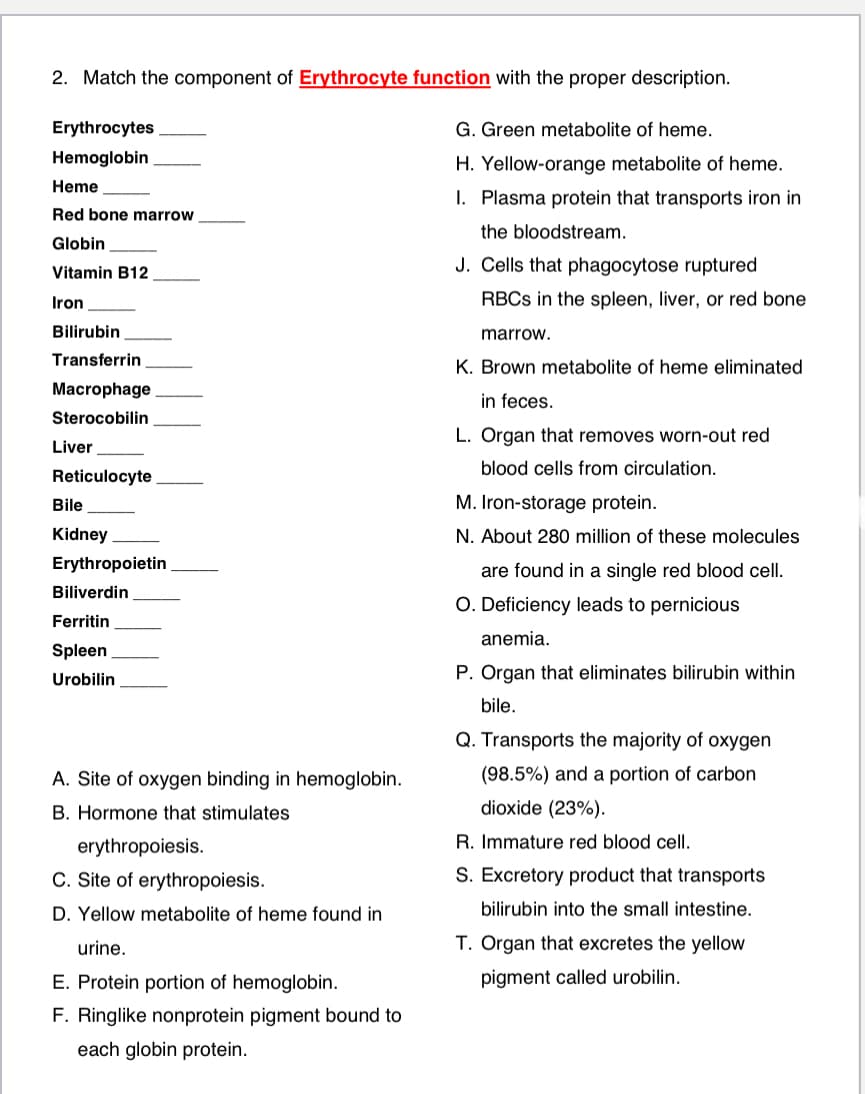2. Match the component of Erythrocyte function with the proper description. Erythrocytes G. Green metabolite of heme. Hemoglobin H. Yellow-orange metabolite of heme. Heme I. Plasma protein that transports iron in Red bone marrow the bloodstream. Globin J. Cells that phagocytose ruptured Vitamin B12 Iron RBCS in the spleen, liver, or red bone Bilirubin marrow. Transferrin K. Brown metabolite of heme eliminated Macrophage in feces. Sterocobilin L. Organ that removes worn-out red Liver blood cells from circulation. Reticulocyte Bile M. Iron-storage protein. Kidney N. About 280 million of these molecules Erythropoietin are found in a single red blood cell. Biliverdin O. Deficiency leads to pernicious Ferritin anemia. Spleen Urobilin P. Organ that eliminates bilirubin within bile. Q. Transports the majority of oxygen A. Site of oxygen binding in hemoglobin. (98.5%) and a portion of carbon B. Hormone that stimulates dioxide (23%). erythropoiesis. R. Immature red blood cell. C. Site of erythropoiesis. S. Excretory product that transports D. Yellow metabolite of heme found in bilirubin into the small intestine. urine. T. Organ that excretes the yellow E. Protein portion of hemoglobin. pigment called urobilin. F. Ringlike nonprotein pigment bound to each globin protein.
2. Match the component of Erythrocyte function with the proper description. Erythrocytes G. Green metabolite of heme. Hemoglobin H. Yellow-orange metabolite of heme. Heme I. Plasma protein that transports iron in Red bone marrow the bloodstream. Globin J. Cells that phagocytose ruptured Vitamin B12 Iron RBCS in the spleen, liver, or red bone Bilirubin marrow. Transferrin K. Brown metabolite of heme eliminated Macrophage in feces. Sterocobilin L. Organ that removes worn-out red Liver blood cells from circulation. Reticulocyte Bile M. Iron-storage protein. Kidney N. About 280 million of these molecules Erythropoietin are found in a single red blood cell. Biliverdin O. Deficiency leads to pernicious Ferritin anemia. Spleen Urobilin P. Organ that eliminates bilirubin within bile. Q. Transports the majority of oxygen A. Site of oxygen binding in hemoglobin. (98.5%) and a portion of carbon B. Hormone that stimulates dioxide (23%). erythropoiesis. R. Immature red blood cell. C. Site of erythropoiesis. S. Excretory product that transports D. Yellow metabolite of heme found in bilirubin into the small intestine. urine. T. Organ that excretes the yellow E. Protein portion of hemoglobin. pigment called urobilin. F. Ringlike nonprotein pigment bound to each globin protein.
Human Anatomy & Physiology (11th Edition)
11th Edition
ISBN:9780134580999
Author:Elaine N. Marieb, Katja N. Hoehn
Publisher:Elaine N. Marieb, Katja N. Hoehn
Chapter1: The Human Body: An Orientation
Section: Chapter Questions
Problem 1RQ: The correct sequence of levels forming the structural hierarchy is A. (a) organ, organ system,...
Related questions
Question

Transcribed Image Text:2. Match the component of Erythrocyte function with the proper description.
Erythrocytes
G. Green metabolite of heme.
Hemoglobin
H. Yellow-orange metabolite of heme.
Heme
I. Plasma protein that transports iron in
Red bone marrow
the bloodstream.
Globin
Cells that phagocytose ruptured
Vitamin B12
Iron
RBCS in the spleen, liver, or red bone
Bilirubin
marrow.
Transferrin
K. Brown metabolite of heme eliminated
Macrophage
in feces.
Sterocobilin
L. Organ that removes worn-out red
Liver
blood cells from circulation.
Reticulocyte
Bile
M. Iron-storage protein.
Kidney
N. About 280 million of these molecules
Erythropoietin
are found in a single red blood cell.
Biliverdin
O. Deficiency leads to pernicious
Ferritin
anemia.
Spleen
P. Organ that eliminates bilirubin within
Urobilin
bile.
Q. Transports the majority of oxygen
A. Site of oxygen binding in hemoglobin.
(98.5%) and a portion of carbon
B. Hormone that stimulates
dioxide (23%).
erythropoiesis.
R. Immature red blood cell.
C. Site of erythropoiesis.
Excretory product that transports
D. Yellow metabolite of heme found in
bilirubin into the small intestine.
urine.
T. Organ that excretes the yellow
E. Protein portion of hemoglobin.
pigment called urobilin.
F. Ringlike nonprotein pigment bound to
each globin protein.
Expert Solution
This question has been solved!
Explore an expertly crafted, step-by-step solution for a thorough understanding of key concepts.
This is a popular solution!
Trending now
This is a popular solution!
Step by step
Solved in 2 steps with 1 images

Recommended textbooks for you

Human Anatomy & Physiology (11th Edition)
Anatomy and Physiology
ISBN:
9780134580999
Author:
Elaine N. Marieb, Katja N. Hoehn
Publisher:
PEARSON

Anatomy & Physiology
Anatomy and Physiology
ISBN:
9781259398629
Author:
McKinley, Michael P., O'loughlin, Valerie Dean, Bidle, Theresa Stouter
Publisher:
Mcgraw Hill Education,

Human Anatomy
Anatomy and Physiology
ISBN:
9780135168059
Author:
Marieb, Elaine Nicpon, Brady, Patricia, Mallatt, Jon
Publisher:
Pearson Education, Inc.,

Human Anatomy & Physiology (11th Edition)
Anatomy and Physiology
ISBN:
9780134580999
Author:
Elaine N. Marieb, Katja N. Hoehn
Publisher:
PEARSON

Anatomy & Physiology
Anatomy and Physiology
ISBN:
9781259398629
Author:
McKinley, Michael P., O'loughlin, Valerie Dean, Bidle, Theresa Stouter
Publisher:
Mcgraw Hill Education,

Human Anatomy
Anatomy and Physiology
ISBN:
9780135168059
Author:
Marieb, Elaine Nicpon, Brady, Patricia, Mallatt, Jon
Publisher:
Pearson Education, Inc.,

Anatomy & Physiology: An Integrative Approach
Anatomy and Physiology
ISBN:
9780078024283
Author:
Michael McKinley Dr., Valerie O'Loughlin, Theresa Bidle
Publisher:
McGraw-Hill Education

Human Anatomy & Physiology (Marieb, Human Anatomy…
Anatomy and Physiology
ISBN:
9780321927040
Author:
Elaine N. Marieb, Katja Hoehn
Publisher:
PEARSON